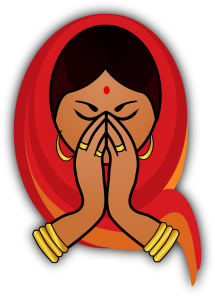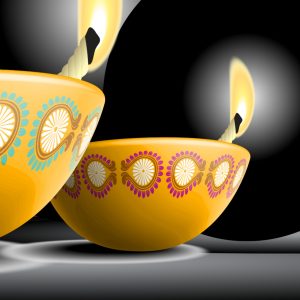
From a lecture given at Śrī Rūpa-Sanātana Gauḍīya Maṭha in Vṛndāvana on February 27, 1994 by Śrīla Bhaktivedānta Nārāyaṇa Mahārāja (Śrī Hari-kathāmṛta Volume Two)
Tomorrow is the day that nitya-līlā-praviṣṭa oṁ viṣṇupāda Śrīla Bhakti Prajñāna Keśava Mahārāja appeared in 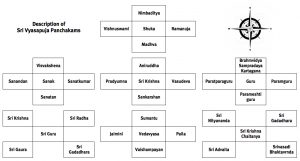 this mortal world. On his birthday my gurudeva, starting with his own guru, would display his faith in all the ācāryas in our paramparā. Bhaktivinoda Ṭhākura invented a system (paddhati) for worship of the paramparā. He collected much of it from the Śaṅkara sampradāya when he lived in Puri. Included within it are kṛṣṇa-pañcaka, guru-pañcaka, vyāsa-pañcaka, ācārya-pañcaka, pañca-tattva-pañcaka and two others, which all together make seven pañcakaṁs for worship. For instance, vyāsa-pañcaka is the worship of Vyāsa and his four disciples headed by Jaiminī and Sumantra. Each pañcaka consisted of five personalities, and in this way he worshipped thirty-five personalities in the paramparā. Why did he do this? By considering oneself a guru and not honouring the paramparā, one cannot attain the kṛṣṇa-prema that is passed down through the disciplic succession. That kṛṣṇa-prema is not an object of this world but of Goloka-Vṛndāvana.
this mortal world. On his birthday my gurudeva, starting with his own guru, would display his faith in all the ācāryas in our paramparā. Bhaktivinoda Ṭhākura invented a system (paddhati) for worship of the paramparā. He collected much of it from the Śaṅkara sampradāya when he lived in Puri. Included within it are kṛṣṇa-pañcaka, guru-pañcaka, vyāsa-pañcaka, ācārya-pañcaka, pañca-tattva-pañcaka and two others, which all together make seven pañcakaṁs for worship. For instance, vyāsa-pañcaka is the worship of Vyāsa and his four disciples headed by Jaiminī and Sumantra. Each pañcaka consisted of five personalities, and in this way he worshipped thirty-five personalities in the paramparā. Why did he do this? By considering oneself a guru and not honouring the paramparā, one cannot attain the kṛṣṇa-prema that is passed down through the disciplic succession. That kṛṣṇa-prema is not an object of this world but of Goloka-Vṛndāvana.
nigama-kalpa-taror galitaṁ phalaṁ
śuka-mukhād amṛta-drava-saṁyutam
pibata bhāgavataṁ rasam ālayam
muhur aho rasikā bhuvi bhāvukāḥ
Śrīmad-Bhāgavatam 1.1.3
O expert and thoughtful men, relish Śrīmad-Bhāgavatam, the mature fruit of the desire tree of Vedic literature. It emanated from the lips of Śrī Śukadeva Gosvāmī. Therefore, this fruit has become even more tasteful, although its nectarine juice was already relishable for all, including liberated souls.
From Kṛṣṇa this fruit passed to Brahmā, then to Nārada, Vyāsa, Śukadeva and through the link to the gurus of present times. The flow never stopped along the way, and for this reason we respect all the gurus in the succession. If we honour one but not another it will be the logic of half a hen. “I only accept what my guru said and wrote”— everything is spoiled for anyone who thinks this way. We should always recognise the entire guru-paramparā. Suppose someone honours his father but not his grandfather— but has he considered from where his father came? So this mentality is not correct. The bhajana of one who does not have a link with the paramparā all the way back to Kṛṣṇa will be useless. For this reason, on his birthday the guru is not so eager to arrange for worship of himself. Arranging for the worship of himself would not be vyāsa-pūjā. Vyāsa-pūjā is the arrangements that the guru makes on his birthday for worshipping the entire line of ācāryas emanating from Vyāsa.
Ordinarily, people believe that they can simply chant the mahā-mantra or any other kṛṣṇa-mantra such as kṛṣṇa śaraṇaṁ mama and concentrate solely on their own guru without caring for any succession of gurus before him. The bhajana of such people will never reach perfection. They may believe otherwise, but they are wrong. They think, “What necessity is there of a paramparā?” But one must come in a line. Sampradāya-vihīnā ye mantrās te viphalā matāḥ: there are many mantras which have come from sources outside the genuine sampradāyas, and they are all bogus. Why? The money which worldly people obtain through their employment can also be obtained by performance of bhajana. But by performance of this type of bhajana one’s anarthas will not be eradicated and one will not attain kṛṣṇa-prema. There is so much discord and strife in this world for the attainment of worldly objects. But what did devotees like Śukadeva Gosvāmī, Rūpa Gosvāmī and Sanātana Gosvāmī do? They completely abandoned all worldly possessions; to them they had no meaning. Otherwise, these possessions would have disturbed their bhajana. For this reason they paid no attention to worldly objects. Those who desire the attainment of worldly objects in their spiritual practice can be sent into the Śukrācārya paramparā: “Go! Be the ācārya of śukra (semen).” From this śukra comes birth, death and everything that is associated with them. These people are finished, trapped in that. We will not move in that direction; we will remain on the straight path illuminated by our guru-paramparā.
In the Śaṅkara sampradāya there is also worship of Vyāsa. Who is Vyāsa? Using a compass situated in one  central point you can expand from that point by drawing a circle. The points in the arc are called vyāsa. He who delineated Kṛṣṇa’s nāma, guṇa, rūpa and līlā in this world is called Vyāsa. By spreading narrations of Bhagavān’s pastimes in this world, he eradicated the jīvas’ ignorance and led them to love of God— this is Vyāsa. He who carries out these same activities while sitting on the throne of Vyāsa is known as an ācārya. The worship of such a great personality is called vyāsa-pūjā.
central point you can expand from that point by drawing a circle. The points in the arc are called vyāsa. He who delineated Kṛṣṇa’s nāma, guṇa, rūpa and līlā in this world is called Vyāsa. By spreading narrations of Bhagavān’s pastimes in this world, he eradicated the jīvas’ ignorance and led them to love of God— this is Vyāsa. He who carries out these same activities while sitting on the throne of Vyāsa is known as an ācārya. The worship of such a great personality is called vyāsa-pūjā.
Before Vyāsa appeared, there were five sages who had propounded their philosophies in scriptures. There was Cārvaka, Kapila who propounded saṅkhya, Kaṇāda who propounded vaiśeṣika, Jaimini who propounded mīmāṁsā and Patañjali who propounded yoga. The name Cārvaka comes from the components cāru and āka. Cāru means “unlimited beauty.” He propounded that there is nothing greater in life than to eat, drink and be merry, associate with the opposite sex, obtain abundant wealth and belongings and be comfortable. Most people accepted this, but then Patañjali came and said, “By following this philosophy, you will ruin yourself.” He taught that although it appears to be sweet, none of this can really be beneficial for us. Patañjali taught that by practising yama, niyama, prāṇayama, dhyāna, dharaṇa, samādhi and so forth all material distress will be mitigated. Then Vyāsa came and taught that all of this is incorrect. Following these philosophies may correct us a little, but ultimately they will not mitigate our suffering or take us to the highest attainment. The jīva is a conscious particle of Bhagavān, and by forgetting him the jīvas have fallen into this world. The jīvas will attain happiness only when they turn towards Bhagavān by serving a genuine spiritual master.
bhayaṁ dvitīyābhiniveśataḥ syād
īśād apetasya viparyayo ’smṛtiḥ
Śrīmad-Bhāgavatam 11.2.37
Misunderstanding himself to be a product of the material energy, the jīva becomes overwhelmed with fear. Deceived by māyā, his position becomes reversed—instead of being the servant of Bhagavān, he becomes opposed to him.
First one must surrender his soul at the feet of a guru. How did the jīva come to this world? By forgetting Bhagavān. Solely due to forgetting Bhagavān, all his intelligence became covered and he was cast far away from Bhagavān. There is vikṣepātmikā-māyā and āvaraṇātmikā-māyā. The jīva is cast far away and his ātmā is covered. Being far away from Bhagavān, he comes in dvitīyābhiniveśa. What does this mean? Disregarding the service of Bhagavān, he becomes engaged in trying to obtain pleasure for himself. This is called dvitīyābhiniveśa. When such a person abandons his material desires and surrenders to a guru, the guru helps him by giving him spiritual knowledge and eventually establishes him at Bhagavān’s feet. How far can such a person go? Along this path automatically all his material distress will be nullified. After this he can go to Vaikuṇṭha, then above there is Ayodhyā-dhāma, above there he enters into Goloka in Dvārakā. Present there are śānta-rasa and dāsya-rasa. Above there he arrives in Vṛndāvana, where there is sakhya-rasa, vātsalya-rasa and finally he attains mādhurya-rasa by the mercy of the guru.
Vyāsa gave all of this in his writings, and especially, to increase peoples’ interest in this, he described Kṛṣṇa’s pastimes in the Tenth Canto of the Bhāgavatam. In the other cantos he described jīva-tattva, māyā-tattva and bhagavat-tattva. In the middle of the Tenth Canto, in chapters twenty-nine through thirty-three, there are five prāṇa, or life-airs. In the middle of them comes the central life-air, chapter thirty-one, the Gopī-gīta. Some rare and fortunate jīvas become attracted to this. He described it in a way that was so beautiful that a comparable description cannot be found in any other scripture. A jīva who is fortunate will endeavour to understand this topic. Next, how will such a person factually attain it? There are two aspects: one is serving Kṛṣṇa when together with him and the other is serving Kṛṣṇa as the vraja-vāsīs do when they are separated from him. The latter is called vipralambha. Attaining this is the ultimate purpose of our lives. But sadly our entire lives seem to pass engaged in menial works without associating with sādhus who can bestow this upon us.
First Vyāsa gave pūrva-rāga in chapter twenty-one, the Veṇu-gīta, and later, after the gopīs saw Kṛṣṇa, comes the Uddhava-sandeśa, Bhramara-gīta and so on. In the Eleventh and Twelfth Cantos he described how we can experience these things through the practice of sādhana. In the Tenth Canto he did not describe sādhana; he only showed what is spiritual greed. In the Eleventh and Twelfth Cantos he showed what is sādhana. In the nineteenth chapter of the Eleventh Canto, Uddhava approaches Kṛṣṇa. What condition was Kṛṣṇa in at that 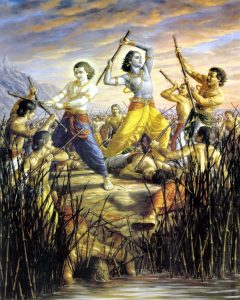 time? In a grave mood he was sitting below a pippala tree while the Yādavas fought amongst themselves and destroyed their dynasty. Then both Uddhava and Maitreya Ṛṣi came to him. Uddhava had some idea that Kṛṣṇa was going to depart for his own abode, so he asked Kṛṣṇa some questions. Through his instructions to Uddhava, Kṛṣṇa instructs us all on this tattva. This chapter is very short but it is very beneficial for the practice of sādhana.
time? In a grave mood he was sitting below a pippala tree while the Yādavas fought amongst themselves and destroyed their dynasty. Then both Uddhava and Maitreya Ṛṣi came to him. Uddhava had some idea that Kṛṣṇa was going to depart for his own abode, so he asked Kṛṣṇa some questions. Through his instructions to Uddhava, Kṛṣṇa instructs us all on this tattva. This chapter is very short but it is very beneficial for the practice of sādhana.
As confirmed in the verse nigama-kalpa-taror (1.1.3), in one sense the entire Bhāgavatam is considered the essence of all the scriptures. Milk itself is considered essence; there is nothing within it which is not usable. By converting it into yoghurt and churning it, butter is produced. Butter is somewhat tasteful to eat, but its essence, ghee, is even more valuable. In the same way, Vyāsa told that everything will come by executing bhagavat-bhakti. How will one attain bhakti? He said that it will be attained through constantly serving the nectarean narrations of Bhagavān’s pastimes. If one chants the holy name but doesn’t hear the nectarean narrations of those pastimes from devotees who are more advanced than himself, his bhakti will remain incomplete. It will become stagnant. We should hear hari-kathā from devotees who are more advanced, in the same line and affectionate to us.
Why have these narrations been described as nectarean? By drinking them one becomes immortal. What is amṛta, nectar? Ānanda, spiritual bliss. The nectar that the demigods drink extends their lifespans but does not protect them from death. Every day at every moment they are dying and suffering there. By drinking this nectar, their lust, anger and madness merely increase, so it cannot really be called amṛta. Liberation has also been referred to as nectar, but there is no real ānanda to be found within liberation. What is real amṛta? That which can bestow for eternal time a condition of great happiness and ānanda. This is kṛṣṇa-sevā. Though all types of kṛṣṇa-sevā are nectarean (amṛtamayī), the sakhya, vātsalya and mādhurya of Vraja are the most intense nectar. Amongst them, mādhurya is the ultimate nectar, as described in the Rāmānanda-samvāda in Caitanya-caritāmṛta.
Therefore, Vyāsa says, “Perpetually serve this amṛtamayī līlā-kathā, or nectarean narrations of Kṛṣṇa’s pastimes, and you will definitely achieve bhakti.” First we should hear it from the guru, understand it and then speak it to others. In this way we will definitely achieve bhakti. We should worship Rādhā-Kṛṣṇa Yugala through service imbued with divine love (premamayī-sevā). Most devotees serve in dāsya, the service mood, and others, especially ladies who live in Vraja, worship a Bāla-Gopāla Deity in the mood of vātsalya, parenthood. Above that is the worship received from a sad-guru, worship of Rādhā-Kṛṣṇa Yugala in the mood of mādhurya. The best method of arcana is performed by those who are indifferent to the path of rules and regulations and instead offer their worship with bhāva. But very few people are qualified to do this. Still, from the beginning of our worship we should try for this method.
We are also advised to worship the guru in a mood of viśrambha, intimacy—viśrambhena gurau-sevā. In my opinion it is not entirely correct to serve the guru with this mood of intimacy while still in the stage of sādhana. Who is this type of service for? For sādhakas who are free from anarthas. For those still under the influence of anarthas, serving the guru with this mood of intimacy will simply become a cause of aparādha. In the beginning stage of sādhana where we are presently situated, we should serve the guru in accordance with the appropriate rules and regulations. If we prematurely adopt this mood of intimacy while serving him, we may even become aggressive towards him. Thinking that he is doing viśrambha-sevā, the disciple will say, “Gurudeva, you should do this and that.” Then, if the guru doesn’t agree to it, what will the so-called viśrambha-sevaka say? “I should leave this guru; in such an atmosphere the guru and disciple cannot remain together.” Then the disciple is finished. So we should remain very vigilant concerning this. Serving with this mood of intimacy is not for our present stage. For now we must follow his orders according to the rules and 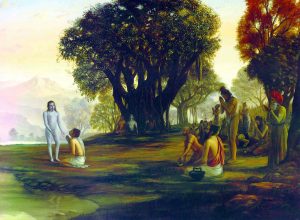 regulations, and then we will automatically enter into viśrambha-sevā.
regulations, and then we will automatically enter into viśrambha-sevā.
The components of the word viśrambha are vigita and śrambha. Vigita means “devoid of,” and śrambha means “awareness of his majesty or greatness.” We should always remaining respectful to him, always remember that he is worshipable, much more advanced and learned than we are, and that there is a great gap between us. Keep in mind that he possesses limitless spiritual opulences and we are ordinary conditioned souls. We should serve him just as Īśvara Purī served Mādhavendra Purī and as Govinda dāsa served Caitanya Mahāprabhu. Jagadānanda Paṇḍita sometimes served Mahāprabhu in the mood of intimacy, but first we must attain Jagadānanda’s level before we can do the same. If we try to do it now, it will cause great problems for us. We should continue with our service according to our own level, always keeping these instructions in mind and remembering how our previous ācāryas served. Once we do genuinely enter into serving the guru with the mood of viśrambha, automatically we will have that mood for Rādhā-Kṛṣṇa also. First it comes in sakhya-rasa, above that in vātsalya-rasa and ultimately in mādhurya-rasa.
Vyāsa analysed all of this. He said to hear hari-kathā, and how should we hear it? According to our specific taste. Those in the mood of śānta will hear narrations of śānta-rasa, those in the mood of dāsya will hear narrations of dāsya-rasa, and so on. It is the same way for the chanting of Bhagavān’s names. A devotee will chant the names that are dear to him, as Gopa-kumāra did in the Bṛhad-bhāgavatāmṛta. Very high standard devotees like Raghunātha dāsa Gosvāmī, Bhaktivinoda Ṭhākura and Gopāla-guru and Dhyānacandra in Puri tasted many varieties of beautiful meanings of the mahā-mantra. They realised a specific meaning for each name of the mantra. Kṛṣṇa’s name appears in the mantra four times, and they tasted a separate meaning for each name. The final name of Kṛṣṇa in the mantra had the highest meaning. The word hare appears eight times in the mantra, and they realised a separate meaning for each time it comes, with its last instance having the highest meaning. The name Rāma comes four times, and they didn’t realise merely the same meaning for each instance of it. According to the specific natures of their bhajana and their bhāva, they tasted particular meanings.
Vyāsa prescribed nāma-kīrtana, deity worship, service to the guru and service to the Vaiṣṇavas. If one desires bhakti, he should abandon all material desires and engage in these four activities. For examples of this, see how in Satya-yuga Aruni left aside personal desires and served his guru. See how Baladeva and Sudāma served Sandipani Muni. See how even an ordinary karmī, Ekalavya, served his guru. His guru asked for his thumb, and at once he cut it off and gave it to him. One guru said to his disciple, Upamanyu, “I see that you are getting fat. What are you eating to be getting so fat?”
“When I take your cows out to graze, after the calves take the cows’ milk, then I also take some.”
“Don’t do this; the calves will go hungry.”
After ten or fifteen days the guru saw that the disciple was still fat. When he asked Upamanyu what he was eating, Upamanyu replied, “I am taking the foam which comes from the cows’ mouths. If I don’t wipe it from their mouths, it will fall to the ground and be wasted. So I wipe it and then eat it.”
The guru said, “Don’t do this either!” But the guru didn’t tell Upamanyu what he could eat. Still Upamanyu somehow remained alive. The guru asked him, “How is it that you are still living?” Upamanyu said he was eating something else, and the guru forbade him to eat that also. In this way the guru forbade him to eat everything but didn’t tell him what he could eat. Though Upamanyu was very weak, he thought, “Somehow I must live. Otherwise, who will take Gurujī’s cows out to graze?” He climbed a tree, picked a large leaf and sucked the white fluid out of it. Then he fell from the tree and injured his eye. As he stumbled away, he fell into a well.
When after some time Upamanyu didn’t return, the guru went searching for him,
calling out, “Where is Upamanyu? Where is he?”
Upamanyu heard him and replied, “Gurujī, I am in the well!” “Why are you in the well?” Then he lifted Upamanyu out.
Upamanyu said, “Gurujī, you told me not to eat, but still I sucked the milk from a leaf.”
Satisfied with Upamanyu’s devotion, the guru said, “May the essence of all the knowledge of the Vedas arise within you.” Then the guru transmitted full realisation of brahma—ahaṁ brahmāsmi—into his heart.
What did Vyāsa give Śukadeva Gosvāmī? Śukadeva Gosvāmī was chanting ahaṁ brahmāsmi in the forest. To entice him back, Vyāsa gave a mantra to a hunter and said to him, “Go to the forest and recite this mantra describing Kṛṣṇa’s beauty. Many parrots will come into your net.” The hunter did so, and not only did many beautiful parrots came into his net, but Śukadeva Gosvāmī also approached him. Śukadeva said to the hunter, “Go ask your guru, ‘If the personality described in this mantra possesses such a beautiful form, what is the nature of his personal qualities?’ ’’
The hunter returned to Vyāsa and told him what happened. The next day Vyāsa taught the hunter a mantra describing Kṛṣṇa’s attributes and told him to recite it in the forest. When the hunter returned to the forest and recited the mantra, Śukadeva was attracted and was automatically caught in Vyāsa’s trap. Then the hunter led him to Vyāsa and Vyāsa taught him the Śrīmad-Bhāgavatam. This is the mercy of Vyāsa. The entire universe is indebted to Vyāsa. He delineated from the beginning level of causeless devotion (ahaituki-bhakti) right up to the highest level of bhakti in such a way that no one has ever matched it since. For this reason, on his own birthday the guru worships Vyāsa and his entire paramparā. It is necessary to worship the entire paramparā. Otherwise, if one respects only his own guru, eventually he will leave that guru. We cannot possibly comprehend the guru’s mercy. If we understood it, there would be no question of ever quarrelling with him over worldly things. He is giving us such a great thing. Very few people in this world understand what it is that the guru is giving and why it is that we are indebted to him. What did those sages do? They left everything behind to serve the feet of the guru. Śukadeva Gosvāmī was immersed in the pleasure of impersonal realisation (brahmānanda), but he condemned it and abandoned it. Then he started serving Vyāsa. What service for the guru can be done by those who don’t understand the value of what he is giving? Even if a disciple gives his life for the guru, it is nothing. Birth after birth we will remain indebted to the guru. Even after attaining perfection we will still remain indebted to him. We can never repay him. For this reason, on his birthday the guru worships not only his own guru but the entire paramparā.
In the very first chapter of Śrī Caitanya-caritāmṛta (Ādi-līlā 1.34) we find this verse in relation to guru-tattva:
vande gurūn īśa-bhaktān
īśam īśāvatārakān
tat-prakāśāṁś ca tac-chaktīḥ
kṛṣṇa-caitanya-saṁjñakam
I offer obeisances unto the spiritual masters, Bhagavān’s devotees, Bhagavān’s incarnations, Bhagavān’s direct manifestations, his potencies and unto Śrī Kṛṣṇa Caitanya himself.
Kṛṣṇadāsa Kavirāja Gosvāmī described these six tattvas in relation to the concept of guru. Many people are confused concerning guru-tattva. Especially these days there is great debate over the issue of dīkṣā-guru and śikṣā-guru. Most of the confusion concerns this point: “I obtained a certain guru in this lifetime. Will I again receive him as my guru in my next life or not?” But this is nothing to be confused about. The śikṣā-guru is described as follows (Śrī Caitanya-caritāmṛta, Ādi-līlā 1.47):
śikṣā-guruke ta’ jāni kṛṣṇera svarūpa
One should know the śikṣā-guru to be the internal form or identity of Śrī Kṛṣṇa (kṛṣṇa-svarūpa).
The dīkṣā-guru has been described in the following words (Śrī Caitanya-caritāmṛta, Ādi-līlā 1.45):
guru kṛṣṇa-rūpa hana śāstrera pramāṇe
guru-rūpe kṛṣṇa kṛpā karena bhakta-gaṇe
According to the evidence of the revealed scriptures, the (dīkṣā) guru is directly the outward form of the Supreme Lord Śrī Kṛṣṇa (kṛṣṇa-rūpa). Kṛṣṇa in the form of the guru bestows mercy upon the devotees.
If the dīkṣā-guru and śikṣā-guru have been described respectively as bhagavad-rūpa, the external form of the Lord, and bhagavad-svarūpa, the internal form of the Lord, where is the question of him changing? Did he change in any birth? The guru will remain the same. Because our intelligence is mundane at present, we cannot understand this point. The guru says that he will come in our every life until we are liberated. It is possible that he will come in the same form and it is also possible that he will be in a different form. Guru is the very form of Kṛṣṇa, as described in those verses, so it is nothing to worry about. We should continue to do sādhana nicely with firm faith in our guru. This is our first priority, and if we take care of this, everything will be fine.
There is also evidence that Kṛṣṇa himself becomes the guru and descends. We also hear that Rādhikā makes an arrangement by sending her dear devotees to this world. Rūpā Gosvāmī and Sanātana Gosvāmī performed bhajana while respecting everyone. We should also perform bhajana in this way. Do we hear that 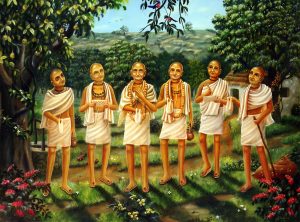 Rūpa and Sanātana ever quarrelled over disciples—“He is my disciple, not yours”? The Six Gosvāmīs didn’t make disciples; only Gopāla-bhaṭṭa made some on the direct order of his superiors. Lokanātha Gosvāmī never accepted disciples. Only upon the great persistence of Jīva Gosvāmī did he accept one disciple, Narottama Ṭhākura. But so many people may be his disciples, as we accept Madhva to be the disciple of Vyāsa. If we are inspired by someone’s writings or narrations of his life and if we follow the conception he taught, then we can be his disciple. If we understand his conception and strictly follow his instructions, he is our śikṣā-guru. Suppose someone goes to Vṛndāvana and always sits near Rūpa Gosvāmī’s samādhi or one of his bhajana-sthalīs. If he constantly speaks about Rūpa Gosvāmī’s teachings and follows his instructions, will Rūpa Gosvāmī not be his śikṣā-guru? Certainly he will. With this verse we offer obeisances to our spiritual masters:
Rūpa and Sanātana ever quarrelled over disciples—“He is my disciple, not yours”? The Six Gosvāmīs didn’t make disciples; only Gopāla-bhaṭṭa made some on the direct order of his superiors. Lokanātha Gosvāmī never accepted disciples. Only upon the great persistence of Jīva Gosvāmī did he accept one disciple, Narottama Ṭhākura. But so many people may be his disciples, as we accept Madhva to be the disciple of Vyāsa. If we are inspired by someone’s writings or narrations of his life and if we follow the conception he taught, then we can be his disciple. If we understand his conception and strictly follow his instructions, he is our śikṣā-guru. Suppose someone goes to Vṛndāvana and always sits near Rūpa Gosvāmī’s samādhi or one of his bhajana-sthalīs. If he constantly speaks about Rūpa Gosvāmī’s teachings and follows his instructions, will Rūpa Gosvāmī not be his śikṣā-guru? Certainly he will. With this verse we offer obeisances to our spiritual masters:
vande ’haṁ śrī-guroḥ śrī-yuta-pada-kamalaṁ śrī-gurūn vaiṣṇavāṁś ca
śrī-rūpaṁ sāgrajātaṁ saha-gaṇa-raghunāthānvitaṁ taṁ sa-jīvam
sādvaitaṁ sāvadhūtaṁ parijana-sahitaṁ kṛṣṇa-caitanya-devaṁ
śrī-rādhā-kṛṣṇa-pādān saha-gaṇa-lalitā-śrī-viśākhānvitāṁś ca
Our own initiating guru is our dīkṣā-guru and the remainder of the personalities mentioned in this verse are our śikṣā-gurus. So will all these personalities be considered inferior to our dīkṣā-guru? Certainly not. Caitanya Mahāprabhu is our śikṣā-guru, so does that make him inferior to our dīkṣā-guru? We shouldn’t see our gurus as being separate from one another. We should continue doing bhajana understanding that guru-tattva is akhaṇḍa, undivided. Then there will be no possibility of any mood of envy or aggression towards any great personality ever entering our hearts.
Vyāsa-pūjā is described in the Caitanya-bhāgavata. It is described there how Nityānanda Prabhu performed vyāsa-pūjā by placing a garland around Mahāprabhu’s neck. Our ācāryas have given a very beautiful conception of how to worship the guru. Following this conception, we should go forward in spiritual life. Tomorrow I will speak in relation to my guru, nitya-līlā-praviṣṭa oṁ viṣṇupāda aṣṭottara-śata Śrī Śrīmad Bhakti Prajñāna Keśava Gosvāmī. When I speak on the life of my guru, I automatically speak about Prabhupāda also. When we glorify Kṛṣṇa, we also necessarily glorify Rādhā. The best praṇāma we can offer to Kṛṣṇa is one in which Rādhikā’s name is included. When I speak on the life of my gurudeva, the glories of Prabhupāda and many other Vaiṣṇavas automatically come within that. In the midst of describing Kṛṣṇa’s pastimes in the Tenth Canto of Śrīmad-Bhāgavatam, what happened? The glories of Rādhikā and the gopīs were described even more. Still, those who are blind say that Rādhikā’s name is not mentioned there. There are hundreds of verses in the Tenth Canto which could be quoted to prove that Rādhikā’s presence is actually there. Practically wherever you look in the Tenth Canto, you will find the glories of the gopīs being described. It is simply not possible to glorify Kṛṣṇa without simultaneously glorifying Rādhikā and the gopīs.
In the same way, it is not possible to glorify a guru without also glorifying his guru. Factually, what is the glory of the spiritual master? That he is the excellent servant of his own spiritual master. Someone who never served his own guru can never be qualified to be a guru, even if he considers himself to be a guru. The guru is one who surrendered his soul to his own guru, who served him constantly and who through that service fulfilled his guru’s innermost desires. One of my gurudeva’s most prominent and great qualities was that he gave everything for his own spiritual master. He even risked his life for his spiritual master. His niṣṭhā was that there was nothing in life that was more important than guru-sevā. If someone ever even slightly criticised Prabhupāda, he could not simply sit quietly and ignore it. In such circumstances some devotees remain patient and keep their composure. This is alright, because it is recommended that one should never become angry. But even within the realm of mundane relationships—if someone hears their mother being verbally abused and doesn’t do anything about it, he must be dull matter and not living. Similarly, if one hears either 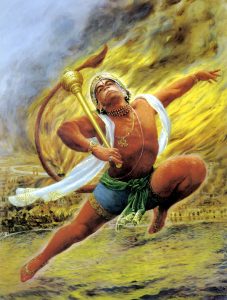 Bhagavān, bhakta or bhakti being blasphemed and doesn’t defend them, then in spiritual life he is dead, not living. We shouldn’t tolerate anyone speaking against Bhagavān, the guru and Vaiṣṇavas or bhakti. At such a time our blood should boil. Hanumān set Lanka alight and burned it to ashes—this is tṛnād api sunicena.
Bhagavān, bhakta or bhakti being blasphemed and doesn’t defend them, then in spiritual life he is dead, not living. We shouldn’t tolerate anyone speaking against Bhagavān, the guru and Vaiṣṇavas or bhakti. At such a time our blood should boil. Hanumān set Lanka alight and burned it to ashes—this is tṛnād api sunicena.
I saw this quality in my gurudeva on many occasions. Once in Navadvīpa the gosvāmīs and smārta-brāhmaṇas tried to impede Prabhupāda’s parikramā party. They were thinking, “If we allow their preaching to continue, people will no longer worship us. Instead, they will begin worshipping the Gauḍīya Vaiṣṇavas. Also, they are trying to take Mahāprabhu’s birthplace away from Navadvīpa and establish it in Māyāpura. We are gosvāmīs by caste but they are saying one is a gosvāmī only on the basis of his personal qualities. If people hear this, they will no longer worship us.” The so-called gosvāmīs believed they were worthy of peoples’ worship even though some of them were illiterate and knew no spiritual philosophy. Prabhupāda’s devotees quoted this verse (Bhagavad-gītā 4.13) to support their position:
cātur-varṇyaṁ mayā sṛṣṭaṁ
guṇa-karma-vibhāgaśaḥ
Kṛṣṇa says, “The four divisions of human society have been created by me on the basis of peoples’ inherent qualities and activities.” In other words, only one who possesses the appropriate qualities can be called a gosvāmī.
This is what those gosvāmīs were so upset about. Prabhupāda was attracting very educated boys from cultured families, giving them initiation and leading them into bhagavad-bhakti. This annoyed many people. They thought, “Hey! He is ruining such good boys by teaching them bhakti! He is telling them that to get married and become absorbed in material life is like committing suicide.” For this reason, many people became angry at Prabhupāda. Prabhupāda himself said that people were opposing him at that time simply because they didn’t understand what he was doing, and that later on, when they came to understand, they would change their feelings towards him. In reality it happened like this, that later on people understood and 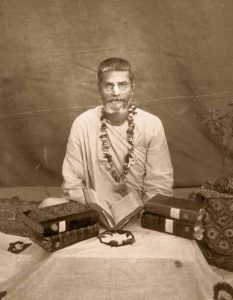 appreciated him.
appreciated him.
When these gosvāmīs attacked Prabhupāda’s party, my gurudeva exchanged clothes with Prabhupāda. Prabhupāda didn’t want to give him his cloth to wear, but forcibly Gurudeva took it from him. Then he sent Prabhupāda to Māyāpura in white cloth and none of the aggressors knew of it. Later the police came and Gurudeva emerged wearing Prabhupāda’s cloth.
Once someone in the Nimbarka sampradāya wrote that Mahāprabhu became a disciple of Keśava Kaśmirī. They said that after Keśava Kaśmirī defeated Mahāprabhu in debate, Keśava Kaśmirī gave him the yugala-mantra and led him into the conception of mādhurya-rasa. When I took this article to Gurudeva and read it to him, he began shaking with fury. He said sternly, “Bring a pen immediately.” When I returned with a pen, he said, “Write!” Then in Bengali he recited only ten or fifteen lines for me to write. The gist of what he said was that there has never been any ācārya named Nimbarka. In the catuḥ-sana sampradāya we find the name of Nimbāditya. If there had been an ācārya named Nimbarka, then Jīva Gosvāmī, any scholar from the Madhva sampradāya or any scholar from any other sampradāya would have mentioned him in their writings. Therefore, this Nimbarka is false. Next, we published this in our Hindi magazine and sent it to their mission by registered post. Then there were many exchanges of letters between us and them. They became very disturbed and brought a court case against Gurudeva for damages of five lākhas. Then Gurudeva wrote, “In court I will defend myself and prove that there was never any ācārya named Nimbarka. Whether or not you will take four lākhas of rupees, we will see afterwards.” We published this in our magazine and sent it to them once more. At this point their reputable lawyers advised them to drop the case against Gurudeva. The lawyers told them that they may have thought they were chasing a worm into a hole, but instead a snake would emerge and finish them with its bite. In the end they dropped their case and have remained silent on the issue ever since.
Some sahajiyā disciples of Bhaktivinoda Ṭhākura in Māyāpura criticised Prabhupāda, saying, “Gauḍīya Maṭha devotees suck only the pit and the skin of the mango. They don’t taste any juice, any rasa. We recite the rāsa-līlā and other elevated topics but Bhaktisiddhānta Sarasvatī doesn’t know anything about these subject matters.” In response to this, Gurudeva wrote five articles in our magazine. Upon reading them, all these sahajiyās became envious and brought a court case against him in Medhinapur. The case named not only Gurudeva but also Narasiṁha Mahārāja, Vāmana Mahārāja, Trivikrama Mahārāja and myself because we were the editors of the magazine. Gurudeva hired the most reputable lawyer in all of Calcutta and in court this lawyer began roaring like a lion. He said, “I will prove to be true whatever my client has written in his magazine.” Everyone in the opposing party became frightened and the judge eventually told them to ask forgiveness from Gurudeva. Then the judge said to Gurudeva, “And don’t you write anymore.” But Gurudeva replied, “I will definitely write. I am a sannyāsī! I exist for the purpose of doing bhajana and for the improvement of society.” After this those sahajiyās never wrote anything against the Gauḍīya Vaiṣṇavas again.
In this way Gurudeva was very influential. For this reason Prabhupāda’s dear disciple, Bhakti Saraṅga Gosvāmī Mahārāja, gave him the title Pāṣaṇḍa-gajaika-siṁha, which means he who like a lion punishes the elephant of atheism. In reality his nature was like that. He was an expert speaker and writer, and especially in writing he employed very embellished language. You can see in our Gauḍīya Patrikā magazine all the beautiful things he wrote in Bengali. Before I write even a little something, I have to look in at least ten books first. He never needed to look in any book before writing something. His guru-sevā was of a very high standard. Everything he did in his entire life—writing, speaking, his conduct, his concepts—were of this high standard. His appearance day is tomorrow, so I pray that he will bless all of us so we can perform bhajana with guru-niṣṭhā similar to his. Then we will be actually capable of helping others.
Image/Art made possible by Pixabay.com & Krishnapath.org


